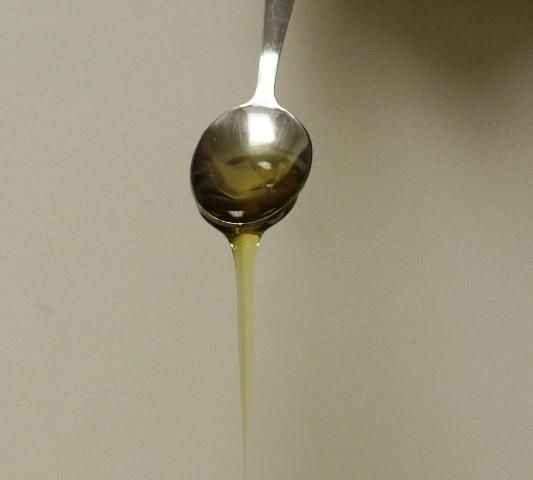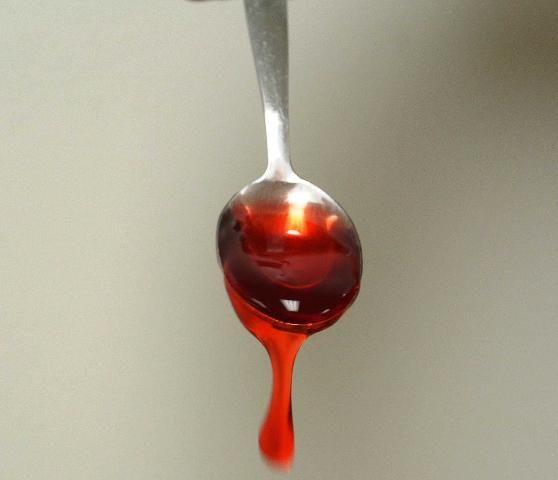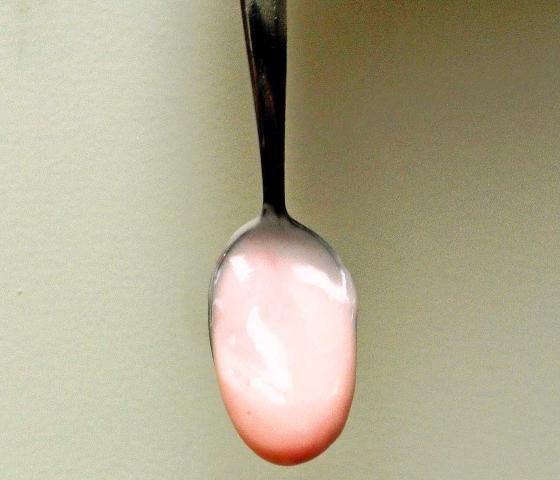Adequate water intake may be a problem for some people who have trouble swallowing, particularly for those who have difficulty swallowing thin liquids. Examples of thin liquids include water, milk, coffee, tea, and most fruit juices. Normally, these beverages contribute significantly to total water intake and serve to prevent dehydration. However, thin liquids move very quickly during the swallowing process, and those with delayed or uncoordinated swallowing may have problems swallowing them (Steele et al. 2015). Some of the liquid may get into the lungs and cause coughing and possibly choking. Thickened liquids are often recommended for individuals who have problems swallowing thin liquids (Cichero et al. 2013).
Thickened Liquids
Thickened liquids are prepared by adding starch or gum thickeners to thin liquids (e.g., water, coffee, tea). The recommended thickness for liquids is specific to the individual with a swallowing problem. The categories of consistencies are slightly thick, mildly thick, moderately thick and extremely thick (Cichero et al. 2017). Slightly thick liquids can be easily sipped through a straw. Mildly thick fluids flow off a spoon, can be sipped from a cup, and with mild effort can be sipped through a straw (Figure 1). Moderately thick liquids can be sipped from a cup, eaten with a spoon, or sipped through a straw with moderate effort. This consistency easily pours from a spoon (Figure 2). Extremely thick liquids can be eaten with a spoon and hold their shape when on a spoon (Figure 3). Extremely thick consistencies are too thick to be sipped from a cup or sucked through a straw (Cichero et al. 2017).

Credit: UF/IFAS

Credit: UF/IFAS

Credit: UF/IFAS
Juice, milk, water, and even coffee can be thickened. Pre-thickened beverages are available commercially, and they also can be prepared with various commercial thickeners. Directions for preparing a thickened beverage depend on the type of thickener used. Product-specific preparation guides are available for preparing the consistencies. However, as individual patient needs differ, it is important to consult with health professionals and create standardized recipes for each food and beverage for everyone with a swallowing problem (dysphagia). Following a recipe produces a consistent thickness, and testing consistencies is essential for quality control and safety. This is especially important if more than one person is involved in the day-to-day preparation of thickened liquids. For detailed information on consistencies of thickened liquids and recommended testing see: https://iddsi.org/IDDSI/media/images/Complete_IDDSI_Framework_Final_31July2019.pdf.
How much water do foods contribute?
Although thickened beverages are served to ensure that individuals with certain swallowing problems receive adequate hydration, it is important to note that foods also provide water and, therefore, contribute to hydration. Many people who require thickened beverages also may require puréed foods. Puréed foods are particularly high in water, typically 70%–90%. Puréed foods are not only sources of water, but they may also provide more nutrients and may be more acceptable than thickened beverages.
Let's consider thickened milk. Fluid milk with 2% fat contains about 89% water. This means that an 8 oz serving (1 cup or 250 mL) of milk provides about 7 oz (220 mL) of water. The addition of starch thickener to the milk has only a small effect on the percentage of water, but it may have a significant effect on taste and acceptability because starch thickeners tend to suppress flavor (Matta et al. 2006). Alternatively, reduced-fat, flavored yogurts contain about 85%–87% water, so an 8 oz serving also provides about 7 oz (220 mL) of water. As yogurts are naturally thick, it is not necessary to add a thickener to ease swallowing. Yogurts offer not only acceptable flavor but also reliable consistency, whereas the consistency of thickened milk may vary with each preparation. It is important to note that water can be provided through a variety of commercially available, flavored yogurts instead of thickened milk. Choose yogurts with added vitamin D to ensure optimal nutrition. Providing water through usual foods such as yogurt is a good option for those who find thickened milk less acceptable.
Another example to consider is thickened juice. Apple juice is considered a beverage, but does it provide more water than applesauce? In fact, both apple juice and applesauce contain about 88% water! A 4 oz (1/2 cup or 125 mL) portion of either provides about 3½ oz (110 mL) of water. The preparation of thickened apple juice requires the addition of a thickener such as starch, whereas applesauce is already thickened due to its fiber content. A disadvantage of thickened apple juice is that it provides no fiber. Carefully consider the need for providing thickened fruit juices versus fruit purées such as applesauce. While both provide water and other nutrients, only the fruit purées provide a significant amount of fiber. Table 1 lists the water and energy contents of common puréed foods and beverages.
The sample menu below meets the MyPlate guidelines (www.MyPlate.gov) (see also MyPlate for Dysphagia [https://edis.ifas.ufl.edu/publication/fs207]). It provides about 1800 mL of water and 1800 kcal (calories) given typical portion sizes, meeting the minimum fluid requirements of 1 mL/kcal (Holiday and Seager 1957). The addition of beverages (thickened if needed) to the menu would provide more water. Although the recommended Adequate Intake (AI) of water for healthy, active women is 2700 mL per day and 3700 mL per day for healthy, active men (IOM 2004), individuals with swallowing problems may be much less active and may live in comfortable, temperature-controlled environments, and thus may have lower fluid requirements.
Sample Puréed Menu
Breakfast
Oatmeal with Milk and Brown Sugar
Scrambled Eggs
Blueberry Yogurt
Banana
Lunch
Salmon Salad
Puréed Bread
Creamed Spinach Purée
Puréed Peaches
Snack
Cottage Cheese with Pears
Light Lemonade (thickened if required)
Dinner
Refried Beans
Corn Grits
Avocado and Salsa Purée
Vegetable Cocktail (thickened if required)
Vanilla Pudding
Evening Snack
Peanut Butter and Jelly Bread Purée
Fruit Smoothie
Where can I get more information?
The Family and Consumer Sciences (FCS) agent at your county Extension office may have more written information and nutrition classes for you to attend. Also, a registered dietitian (RD) can provide reliable information.
References
Cichero, J. A., P. Lam, C. M. Steele, B. Hanson, J. Chen, R. O. Dantas, J. Duivestein, J. Kayashita, C. Lecko, J. Murray, M. Pillay, L. Riquelme, and S. Stanschus. 2017. "Development of International Terminology and Definitions for Texture-Modified Foods and Thickened Fluids Used in Dysphagia Management: The IDDSI Framework." Dysphagia 32(2): 293–314. doi: 10.1007/s00455-016-9758-y.
Cichero, J. A., C. M Steele, J. Duivestein, P. Clave, J. Chen, J. Kayashita, R. O. Dantas, C. Lecko, R. Speyer, P. Lam, and J. Murray. 2013. "The Need for International Terminology and Definitions for Texture-Modified Foods and Thickened Liquids Used in Dysphagia Management: Foundations of a Global Initiative." Current Physical Medicine and Rehabilitation Reports 1: 280–291. doi: 10.1007/s40141-013-0024-z.
Holiday, M. A., and W. E. Seager. 1957. "The Maintenance Need for Water in Parenteral Fluid Therapy." Pediatrics 19: 823.
Institute of Medicine (IOM). 2004. "Dietary Reference Intakes for Water, Potassium, Sodium, Chloride, and Sulfate." Accessed September 7, 2022. https://doi.org/10.17226/10925
Matta, Z., E. Chambers, J. Mertz Garcia, and J. M. McGowan Helverson. 2006. "Sensory Characteristics of Beverages Prepared with Commercial Thickeners Used for Dysphagia Diets." Journal of the American Dietetic Association 106(7): 1049–54. doi: 10.1016/j.jada.2006.04.022.
Steele, C. M., W. A. Alsanei, S. Ayanikalath, C. E. Barbon, J. Chen, J. A. Cichero, K. Coutts, R. O. Dantas, J. Duivestein, L. Giosa, B. Hanson, P. Lam, C. Lecko, C. Leigh, A. Nagy, A. M. Namasivayam, W. V. Nascimento, I. Odendaal, C. H. Smith, and H. Wang. 2015. "The Influence of Food Texture and Liquid Consistency Modification on Swallowing Physiology and Function: A Systematic Review." Dysphagia 30 (1):2–26. doi: 10.1007/s00455-014-9578-x.
USDA (United States Department of Agriculture). 2022. "FoodData Central." Accessed September 7, 2022. https://fdc.nal.usda.gov/